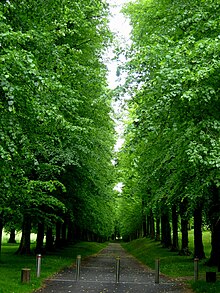Tilia × europaea, generally known as the European lime,[1] common lime (British Isles) or common linden, is a naturally occurring hybrid between Tilia cordata (small-leaved lime) and Tilia platyphyllos (large-leaved lime). It occurs in the wild in Europe at scattered localities wherever the two parent species are both native.[2][3] It is not closely related to the lime fruit tree, a species of citrus.
| Tilia × europaea | |
|---|---|

| |
| Avenue of common limes, Hampshire, UK | |
| Scientific classification | |
| Kingdom: | Plantae |
| Clade: | Tracheophytes |
| Clade: | Angiosperms |
| Clade: | Eudicots |
| Clade: | Rosids |
| Order: | Malvales |
| Family: | Malvaceae |
| Genus: | Tilia |
| Species: | T. × europaea
|
| Binomial name | |
| Tilia × europaea | |
| Synonyms | |
| |
Description edit
Tilia × europaea is a large deciduous tree up to 15–50 metres (49–164 feet) tall with a trunk up to 2.5 m (8 ft). The base of the trunk often features burrs and a dense mass of brushwood.[4] The leaves are intermediate between the parents, 6–15 centimetres (2–6 inches) long and 6–12 cm (2–5 in) broad, thinly hairy below with tufts of denser hairs in the leaf vein axils. The flowers are produced in clusters of four to ten in early summer with a leafy yellow-green subtending bract; they are fragrant, and pollinated by bees. The floral formula is ✶ K5 C5 A0+5∞ G(5).[5] The fruit is a dry nut-like drupe 8 millimetres (3⁄8 in) in diameter, downy and faintly ribbed.[2]
Cultivation edit
This hybrid is very widely cultivated, being readily and inexpensively propagated by layering; as a result, it is often the commonest Tilia species in urban areas and along avenues and streets. It is not however the best species for this purpose, as it produces abundant stem sprouts, and also often hosts heavy aphid populations resulting in honeydew deposits on everything underneath the trees. Furthermore, there is substantial leaf litter in autumn (fall).[2]
Notable trees edit
One long-lived example was the "Malmvik lime", planted as a sapling near the Malmvik Manor in Stockholm, Sweden in 1618. The tree existed for 381 years until the last part of the tree fell in a storm in 1999.[6] The UK Tree Register Champion is at Aysgarth, Yorkshire, measuring 26 m (85 ft) in height and 295 cm (9 ft 8 in) diameter at breast height in 2009.[7] The tree in front of Augustusburg Hunting Lodge in Saxony was planted in 1421 according to the chronicles of Augustusburg.[8] Some 13 limes were planted at Mullary cemetery Co Louth Ireland to commemorate "king Billy's" victory at the battle of the Boyne in circa 1669 as lime are not native to Ireland and they were planted to mark the foreign victory, they remain standing today.
Uses edit
The leaves, except for their stalks, can be eaten raw.[9]
The infusion of its blossoms functions as a mild relaxant.
The wood of the lime was commonly used by Vikings in their shields.[citation needed]
References edit
- ^ "European Linden Tree Facts". Home Guides | SF Gate. Retrieved 2022-08-21.
- ^ a b c Rushforth, K. (1999). Trees of Britain and Europe. Collins ISBN 0-00-220013-9.
- ^ Flora of NW Europe: Tilia × europaea[permanent dead link]
- ^ Alan Mitchell, The Field Guide to the Trees of Britain and Northern Europe, William Collins & Co Ltd 1974, ISBN 0-00-219213-6 (p.359)
- ^ Ronse De Craene, Louis P. (2010-02-04). Floral Diagrams: An Aid to Understanding Flower Morphology and Evolution. Cambridge: Cambridge University Press. p. 225. ISBN 978-0-521-49346-8.
- ^ Bengtsson, Rune (Winter 2004). "The Malmvik Lime: An Historical and Biological Analysis of the Oldest Documented Planting of Common Lime (Tilia x Europaea L.) in Sweden". Garden History. 32 (2). The Garden History Society: 188–196. doi:10.2307/4150380. JSTOR 4150380.
- ^ Johnson, O. (2011). Champion Trees of Britain & Ireland. p.165. Kew publishing, Royal Botanic Gardens Kew, London.
- ^ Lemke, Karl (1988). Naturdenkmale Bäume, Felsen, Wasserfälle. Hartmut Müller (1. Aufl ed.). Berlin. ISBN 978-3-350-00284-9. OCLC 75004491.
{{cite book}}: CS1 maint: location missing publisher (link) - ^ Mabey, Richard (2012). Food for Free. London: Collins. p. 57. ISBN 978-000-743847-1.
External links edit
- Media related to Tilia × europaea at Wikimedia Commons
- Photos, measurements and location details of ancient common lime trees